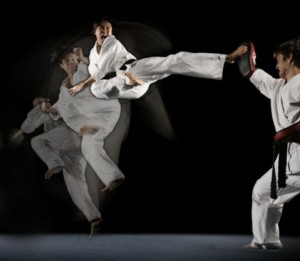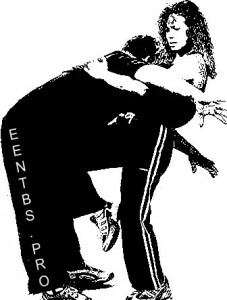By Stefan Verstappen,Originally published in Black Belt Magazine May 07
If there is one word that can sum up what martial arts teach, that is power. The creation and use of power or energy (Chi in Chinese or Ki in Japan) is the primary focus of many martial arts. Breathing techniques, weight training, conditioning exercises, drills, forms, nutrition, and meditation all are ways of generating and directing energy.
All masters know that there are two forms of this energy, the yin and the yang, the creative and the destructive.Martial arts rightly focus on generating creative energy through fitness, self-discipline, and honor. Nevertheless, a martial artist must also learn to master the dark side of the force, the creation and application of destructive energy. The following describes three types of destructive energy, how they work, and where and how to apply them in combat.
Penetrating strikes are best used against soft tissue targets such as nerve clusters, and internal organs. For example, if you were to use a Snake Hand strike (the hand extended flat using the fingertips as the striking surface) against an opponent’s chest, it has no chance of penetrating the sternum and a high chance of breaking your fingers. However, if delivered to the throat, it is capable of lacerating the larynx or blistering the carotid artery, both lethal injuries.
To apply penetrating energy requires you to focus through the intended target. For example, a punch to the solar plexus should be focused through the opponent’s body as though attempting to strike the spine rather than the stomach. This helps to neutralize the subconscious tendency to slow down the strike as it nears the target. A simple way to train and test your penetrating strikes is to take an empty cardboard box like the kind your TV or Microwave came in. Then set it on a table and insure there is a clear area all around. Now strike the box using a Snake Hand, Leopard Paw or Phoenix Eye strike. If you can punch clean little holes in the cardboard without the box flying off the table, you will have mastered this method.
Crushing energy uses the weapon’s mass to focus energy over a larger area to rupture nerves and blood vessels and to break bones. Anatomical weapons that use crushing energy include the head butt, elbow and knee strikes, most punches and kicks. Weapons that use crushing energy include the mace, war hammer, clubs, and baseball bats.
Crushing energy strikes are best directed at areas less massive than the weapon used. For example, a punch to the bridge of the nose can easily crush and break the septal cartilage causing extreme pain and bleeding, but a punch to the forehead will probably break the puncher’s hand instead.
To apply crushing energy, you must engage as much of the body’s mass into the strike as possible. To bring the body’s mass into a technique requires that the centre of gravity move along with the impact. For example, in executing a Hammer Fist strike to the opponent’s collarbone, you must lower your centre of gravity by bending the knees with the impact. This adds the body’s mass to that of the fist. In punching forwards, the legs are used to propel your centre of gravity forward behind the punch as though the arm where a battering ram and the body the carriage. The best way to test and train your crushing power is through breaking techniques.
Transferring Energy
A strike that uses transferring energy causes a concussion by creating a pressure wave that transfers energy directly into the body without penetrating the outer skin and muscle. This principle can be seen in action on the pool table. Using of bit of ‘English’ (backspin), a cue ball striking a stationary billiard ball will come to a complete stop while the billiard ball rolls away with the momentum the cue ball had. The cue ball had transferred all its kinetic energy into the billiard ball. Transferring energy strikes work in the same way, the striking weapon comes to a stop on the surface of the opponent’s body but the energy has been transferred into the body in the form of a pressure wave.
Anatomical weapons that employ transferring energy include certain punches, palms strikes, and the roundhouse kick. Because of the complexity this technique, few ancient weapons employed it. To some extent, whips and flails such as the Nunchakus employ transference energy. A bullwhip, while it uses the reverse motion to generate an energy wave, focuses the wave into the whip itself to increase velocity so that the tip becomes a cutting weapon.
A legendary example of a transference strike is the `Heart Palm’ strike. The Heart Palm is executed using the heel of the palm and is targeted to the centre of the chest. The energy is transferred through the chest wall and into the heart’s pacemaker located just behind the sternum. The pacemaker is a magnetically polarized patch of tissue that regulates the heartbeat. Like an iron nail that has been given a magnetic charge (by rubbing with a magnet), a sudden shock like dropping the nail will cause the nail to lose its charge. So too the pacemaker can lose its magnetic charge through a sudden shock. This can result in a twitching of the heart muscle (ventricular fribulation) and eventually to cardiac arrest if not treated immediately. On the surface, there is no sign of injury since the energy has been transferred through the surface to cause damage internally.
To apply a transferring strike you must incorporate a reverse motion to the technique by drawing back on the strike just before impact. This can be likened to a whip, in order to `crack’ the whip you must pull back just before the end of the swing. This pulling back is best done by using the waist and is called Silk Reeling in the Chinese styles. For example, to add concussion energy to a reverse punch, your hips should first shift forwards throwing the weight of the body into the punch, but just before impact, the hips shift back so that the kinetic energy behind the punch travels into the target but the fist does not.
To train and test you concussion strikes, set up a candle on a table, clear the area, and be prepared to have hot wax splashed across the room. Aim a punch or palm strike directly at the flame but make sure you stop short about an inch away from the flame. Done correctly, the flame will be extinguished with a slight popping sound. Done incorrectly, and you usually have a mess to clean up.
Conclusion
These three destructive forces have been used in warfare since earliest time. The spear, club and flail are probably the earliest weapons invented that use these three forces. Even modern warfare employs these time-honored principles. For example, to disable armored vehicles the military developed three weapons. The SBOT round, which is a sharp hard projectile made from depleted uranium designed to Penetrate the vehicle’s armor. The HEAT (High Explosive Anti Tank) round uses high explosive to Crush a vehicle, and the old fashioned bazooka or Panzerfaust uses the Transference principle to blast off a scab of amour plating from the interior sending chucks of metal ricocheting inside the vehicle.
The martial arts teach not only how to develop strength and power but also the knowledge and skill to deliver the three types of destructive energy to their appropriate targets. A side-kick to the solar plexus (Penetrating), a hammer-fist to the brachial plexus (Crushing), or a palm strike to the forehead (Concussion), will often instantly knock an attacker unconscious while causing him or her the least injury. In this way, even the dark side of the force can be used for good, to protect you and you family, and cause the least amount of harm in return.

